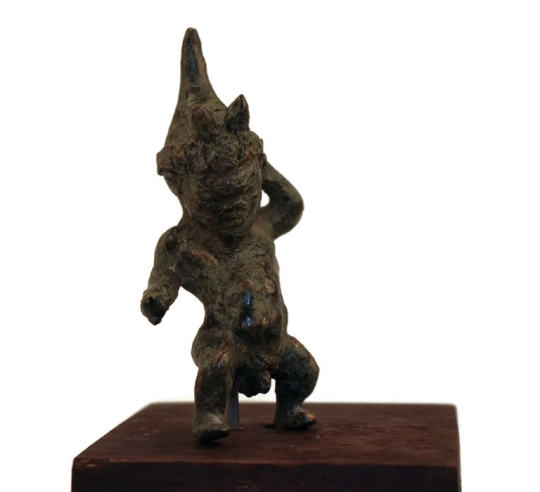- New
Greek statuette of a dancing dwarf or pygmy
Reproduction of a Greek statuette of a dancing dwarf or pygmy
The figure represented is characterized mainly by its small size, by its short legs, and by the negative features of its face: it is a dwarf or pygmy (during the Hellenistic period, images of Pygmies, which are ethnic dwarves, are treated in the same way as pathological dwarfs). His legs are spread apart, with the right hand moving forward as if he were jumping or dancing. The left arm is raised and the hand is placed close to the ear, as if it were imitating the gesture of someone who wants to hear something better or asks to repeat a sentence. In his other hand (the right arm is lowered to the thigh), this small figure holds a spherical object, which can be identified as a ball.
This statuette is part of the large family of "grotesques", a term that designates objects, usually small in size and of varied artistic quality, that exploit physical deformations and human diseases to create a caricatural effect and amuse the viewer, rather than imitate reality. Images of men or, rarely, women and children, emaciated or obese, old people, dwarves, Africans, emaciated or obese, etc.
Dimensions
Height: 9,5 cm.
Width: 5,5 cm.
Depth: 4 cm.
Weight: 220 g.
Material: Resin.
Publisher: Temarte S.L.
Despite its unusual proportions (the legs and, to a lesser extent, the arms are too short and muscular compared to the size of the chest and head), the anatomy of the body and head is extremely elaborate and perfectly modeled: he is gifted with very athletic musculature while his probable African origin is indicated by the flat face, pug nose and full lips. His short, curly hair is held back by a twisted crown that encircles his head: two bumps just above the forehead may be small horns.
The proportions of the figurine are characteristic of representations of dwarfs from Antiquity. Although the ancients did not have the scientific means to explain the varied malformations known under the term “dwarfism”, they were able to feature the most obvious external aspects: disproportionate members, too large head, flat face, prominent stomach and buttocks, spine malformation, etc.
The general posture, which is that of a juggler or a dancer, recalls the vivacity of many depictions of Hellenistic Greek or Roman dwarfs, as they certainly would have been seen in the streets of large ancient cities such as Alexandria, Antioch, Athens or Rome.



















